重庆市铜梁县第一中学2020学年高一英语6月月考试题
- 格式:doc
- 大小:132.50 KB
- 文档页数:17
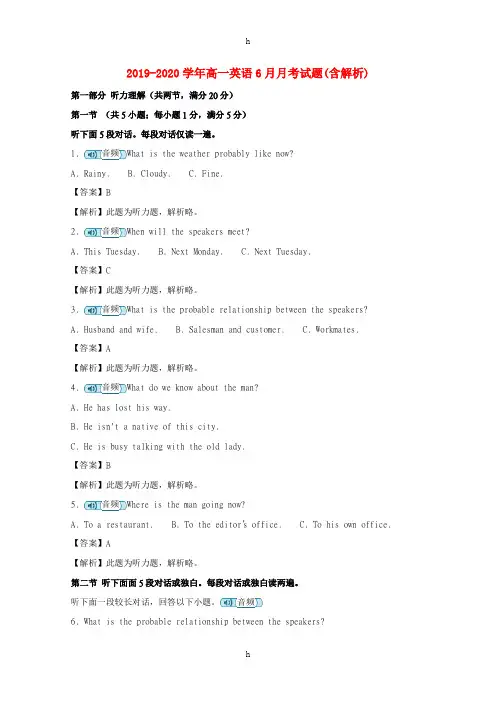
2019-2020学年高一英语6月月考试题(含解析)第一部分听力理解(共两节,满分20分)第一节(共5小题;每小题1分,满分5分)听下面5段对话。
每段对话仅读一遍。
1. 音频What is the weather probably like now?A. Rainy.B. Cloudy.C. Fine.【答案】B【解析】此题为听力题,解析略。
2. 音频When will the speakers meet?A. This Tuesday.B. Next Monday.C. Next Tuesday.【答案】C【解析】此题为听力题,解析略。
3. 音频What is the probable relationship between the speakers?A. Husband and wife.B. Salesman and customer.C. Workmates.【答案】A【解析】此题为听力题,解析略。
4. 音频What do we know about the man?A. He has lost his way.B. He isn't a native of this city.C. He is busy talking with the old lady.【答案】B【解析】此题为听力题,解析略。
5. 音频Where is the man going now?A. To a restaurant.B. To the editor’s office.C. To his own office.【答案】A【解析】此题为听力题,解析略。
第二节听下面面5段对话或独白。
每段对话或独白读两遍。
听下面一段较长对话,回答以下小题。
音频6. What is the probable relationship between the speakers?A. Father and daughter.B. Neighbors.C. Husband and wife7. Why does the man talk to the woman?A. He wants to talk about her study.B. She always sings loudly at night.C. She turns up her TV too much.【答案】6. B 7. C【解析】此题为听力题,解析略。
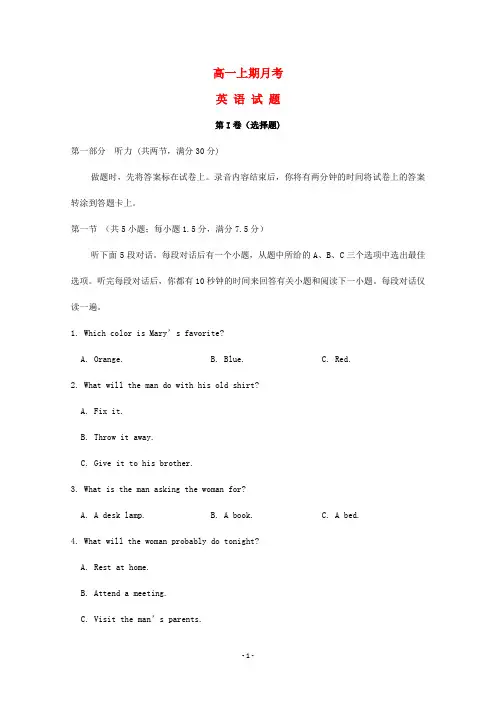
高一上期月考英语试题第I卷(选择题)第一部分听力 (共两节,满分30分)做题时,先将答案标在试卷上。
录音内容结束后,你将有两分钟的时间将试卷上的答案转涂到答题卡上。
第一节(共5小题;每小题1.5分,满分7.5分)听下面5段对话。
每段对话后有一个小题,从题中所给的A、B、C三个选项中选出最佳选项。
听完每段对话后,你都有10秒钟的时间来回答有关小题和阅读下一小题。
每段对话仅读一遍。
1. Which color is Mary’s favorite?A. Orange.B. Blue.C. Red.2. What will the man do with his old shirt?A. Fix it.B. Throw it away.C. Give it to his brother.3. What is the man asking the woman for?A. A desk lamp.B. A book.C. A bed.4. What will the woman probably do tonight?A. Rest at home.B. Attend a meeting.C. Visit the man’s parents.5. Where are the speakers?A. At a flower shop.B. In the woman’s yard.C. On a farm.第二节听下面5段对话或独白。
每段对话或独白后有几个小题,你将有时间阅读各个小题,每小题5秒钟;听完后,各小题将给出5秒钟的作答时间。
每段对话或独白读两遍。
听第6段材料,回答第6、7题。
6. Who is the man buying a gift for?A. His mother.B. His classmate.C. His English teacher.7. What will the man buy?A. Coffee cups.B. Flowers.C. Notebooks.听第7段材料,回答第8、9题。
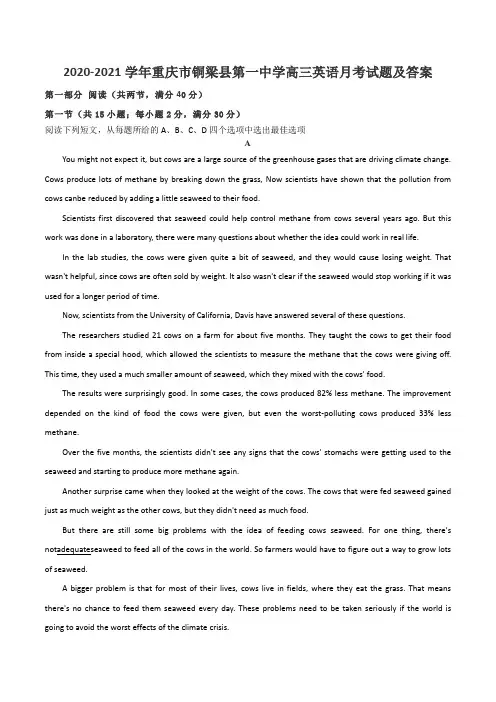
2020-2021学年重庆市铜梁县第一中学高三英语月考试题及答案第一部分阅读(共两节,满分40分)第一节(共15小题;每小题2分,满分30分)阅读下列短文,从每题所给的A、B、C、D四个选项中选出最佳选项AYou might not expect it, but cows are a large source of the greenhouse gases that are driving climate change. Cows produce lots of methane by breaking down the grass, Now scientists have shown that the pollution from cows canbe reduced by adding a little seaweed to their food.Scientists first discovered that seaweed could help control methane from cows several years ago. But this work was done in a laboratory, there were many questions about whether the idea could work in real life.In the lab studies, the cows were given quite a bit of seaweed, and they would cause losing weight. That wasn't helpful, since cows are often sold by weight. It also wasn't clear if the seaweed would stop working if it was used for a longer period of time.Now, scientists from the University of California, Davis have answered several of these questions.The researchers studied 21 cows on a farm for about five months. They taught the cows to get their food from inside a special hood, which allowed the scientists to measure the methane that the cows were giving off. This time, they used a much smaller amount of seaweed, which they mixed with the cows' food.The results were surprisingly good. In some cases, the cows produced 82% less methane. The improvement depended on the kind of food the cows were given, but even the worst-polluting cows produced 33% less methane.Over the five months, the scientists didn't see any signs that the cows' stomachs were getting used to the seaweed and starting to produce more methane again.Another surprise came when they looked at the weight of the cows. The cows that were fed seaweed gained just as much weight as the other cows, but they didn't need as much food.But there are still some big problems with the idea of feeding cows seaweed. For one thing, there's notadequateseaweed to feed all of the cows in the world. So farmers would have to figure out a way to grow lots of seaweed.A bigger problem is that for most of their lives, cows live in fields, where they eat the grass. That means there's no chance to feed them seaweed every day. These problems need to be taken seriously if the world is going to avoid the worst effects of the climate crisis.Still, it's true that something as simple as feeding cows seaweed can help reduce some of the pollution causing the climate crisis.1. Why did the scientists do the experiment on the farm?A. To control the amount of seaweed.B. To record the weight cows gained.C. To confirm the effect of seaweed in real life.D. To measure the amount of seaweed cows ale.2. The underlined word “adequate” means ________ .A. commonB. specialC. lackingD. enough3. The passage is written to ________ .A. appeal to people not to raise the cowsB. encourage people to plant the seaweedC. remind people of controlling cows' weightD. call on people to take actions to reduce the pollutionB“Heavy hearts, like heavy clouds in the sky, are best relieved by the letting of a little water, the French writer Antoine de Rivarol wrote. This love letter to the cleansing beauty of a good cry is a comforting thought at atime when the continuing stress of the COVID-19 has added heaviness to each of our lives.Scientifically, de Rivarol's poetic image doesn't, if you'll forgive the words used in the poem, hold water. There's limited research on crying, partly because of the difficulty of copying the behavior of real crying in a lab. But even within the previous studies, there's little evidence to suggest that crying provides a physiological cleansing of poisons in people's body.Psychologists believe the relief of a good cry connects with a different emotional process. “It seems that crying occurs just after the peak of the emotional experience, and crying is associated with this return to homeostasis: the process of maintaining a stable psychological state,” said Lauren Bylsma. He also said holding back tears can have negative physical consequences, including headaches and muscle tension. Such restriction can also limit our experiences of joy, gratitude and other positive emotions if we avoid acknowledging our feelings.For me crying has been easier said than done during the COVID-19. Psychologists say it's normal to feel stopped up by the stresses of the past year. We should find opportunities to release and process our emotions.Watching a tear-jerking movie, having an emotional conversation with a close friend, and writing in a journal are healthy ways toelicita cry. Physical activity like light-footed walking or even dancing can also signal our bodies to release some emotional tightness. We can then open up to the flow of feelings that leave us feeling lighter and refreshed—like a clear sky after a soaking rain.4. What is the weakness of the studies ever clone on crying?A. They were clone in a laboratory setting.B. They cared little about different forms of crying.C. They were always concentrated on people's daily life.D. They showed little about the positive physical effect of crying.5. What is the function of crying according to Lauren Bylsma?A. Curing people of their diseases.B. Keeping emotionally balanced.C. Producing negative mental results.D. Expanding people's experience of joy.6. What does the underlined word “elicit” in the last paragraph mean?A. Produce.B. Postpone.C. Control.D. Repeat.7. What are people advised to do according to the text?A. Learn to hold back their tears wisely.B. Share their emotion with their colleagues.C. Have a good cry when necessary.D. Try to avoid admitting our feelings.CIn 2015, a man named Nigel Richards memorized 386, 000 words in the entireFrench Scrabble Dictionaryin just nine weeks. However, he does not speak French. Richards’ impressive feat is a useful example to show how artificial intelligence works — real AI. Both of Richard and AI take in massive amounts of data to achieve goals with unlimited memory and superman accuracy in a certain field.The potential applications for AI are extremely exciting. Because AI canoutperformhumans at routine tasks — provided the task is in one field with a lot of data — it is technically capable of replacing hundreds of millions of white and blue collar jobs in the next 15 years or so.But not every job will be replaced by AI. In fact, four types of jobs are not at risk at all. First, there are creative jobs. AI needs to be given a goal to optimize. It cannot invent, like scientists, novelists and artists can. Second, the complex, strategic jobs — executives, diplomats, economists — go well beyond the AI limitation of single-field and Big Data. Then there are the as-yet-unknown jobs that will be created by AI.Are you worried that these three types of jobs won’t employ as many people as AI will replace? Not to worry, as the fourth type is much larger: jobs where emotions are needed, such as teachers, nannies and doctors. These jobs require compassion, trust and sympathy — which AI does not have. And even if AI tried to fake it, nobodywould want a robot telling them they have cancer, or a robot to babysit their children.So there will still be jobs in the age of AI. The key then must be retraining the workforce so people can do them. This must be the responsibility not just of the government, which can provide funds, but also of corporations and those who benefit most.8. What is the main purpose of paragraph 1?A. To introduce the topic.B. To mention Nigel’s feat.C. To stress the importance of good memory.D. To suggest humans go beyond AI in memory.9. Which of the following best explains “outperform” underlined in paragraph 2?A. Be superior toB. Be equal toC. Be similar toD. Be related to10. Which of the following jobs is the most likely to be replaced?A. The writer.B. The shop assistant.C. The babysitter.D. The psychologist.11. What does the text suggest people do about job replacement of AI?A. Limit the application of AI to a certain degree.B. Get more support from the government.C. Apply for the donation from companies.D. Upgrade themselves all the time.DYou've probably heard it suggested that you need to move more throughout the day, and as a general rule of thumb, that "more" is often defined as around 10,000 steps. With many Americans tracking their stepsvia new fitness-tracking wearables, or even just by carrying their phone, more and more people use the 10,000-step rule as their marker for healthy living. Dr. Dreg Hager, professor of computer science at Johns Hopkins, decided to take a closer look at that 10,000-step rule, and he found that usingitas a standard may be doing more harm than good for many.“It turns out that in 1960 in Japan they figured out that the average Japanese man, when he walked 10,000 steps a day burned something like 3,000 calories and that is what they thought the average person should consume so they picked 10,000 steps as a number” Hager said.According to Hager, asking everyone to shoot for 10,000 steps each day could be harmful to the elderly or those with medical conditions, making it unwise for them to jump into that level of exercise, even if it's walking. The bottom line is that 10,000 steps may be too many for some and too few for others. He also noted that those with shorter legs have an easier time hitting the 10,000-step goal because they have to take more steps than people with longer legs to cover the distance. It seems that 10,000 steps may be suitable for the latter.A more recent study focused on older women and how many steps can help maintain good health and promote longevity (长寿).The study included nearly 17,000 women with an average age of 72. Researchers found that women who took 4,400 steps per day were about 40% less likely to die during a follow-up period of just over four years: Interestingly, women in the study who walked more than 7,500 steps each day got no extra boost in longevity.12. What does the underlined word "it' in Paragraph 1 refer to?A. The phone recording.B. The 10,000-step rule.C. The healthy living.D. The fitness-tracking method.13. What does Paragraph 2 mainly talk about?A. How many steps a Japanese walks.B. How we calculate the number of steps.C. If burning 3,000 calories daily is scientific.D. Where 10,000 steps a day came from.14. Who will probably benefit from 10,000 steps each day according toHager?A. Senior citizens.B. Young short-legged people.C. Healthy long-legged peopleD. Weak individuals.15. How many steps may the researchers suggest senior citizens take each day?A. 4,400 steps.B. 10,000 steps.C. 2,700 steps.D. 7,500 steps.第二节(共5小题;每小题2分,满分10分)阅读下面短文,从短文后的选项中选出可以填入空白处的最佳选项。
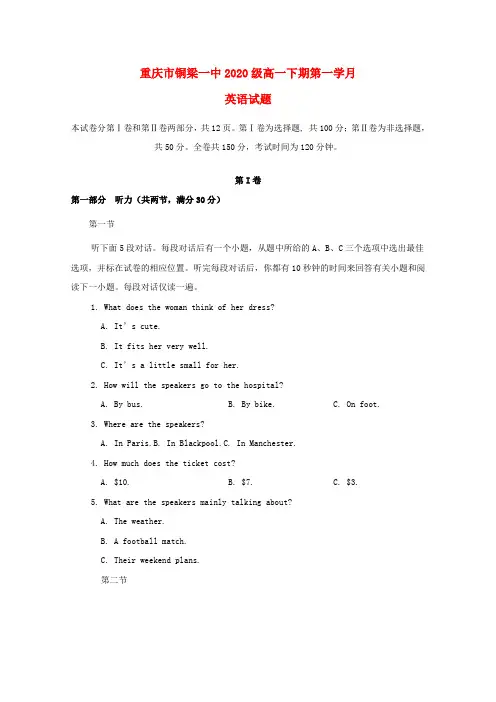
重庆市铜梁一中2020级高一下期第一学月英语试题本试卷分第Ⅰ卷和第Ⅱ卷两部分,共12页。
第Ⅰ卷为选择题, 共100分;第Ⅱ卷为非选择题,共50分。
全卷共150分,考试时间为120分钟。
第I卷第一部分听力(共两节,满分30分)第一节听下面5段对话。
每段对话后有一个小题,从题中所给的A、B、C三个选项中选出最佳选项,并标在试卷的相应位置。
听完每段对话后,你都有10秒钟的时间来回答有关小题和阅读下一小题。
每段对话仅读一遍。
1. What does the woman think of her dress?A. It’s cute.B. It fits her very well.C. It’s a little small for her.2. How will the speakers go to the hospital?A. By bus.B. By bike.C. On foot.3. Where are the speakers?A. In Paris.B. In Blackpool.C. In Manchester.4. How much does the ticket cost?A. $10.B. $7.C. $3.5. What are the speakers mainly talking about?A. The weather.B. A football match.C. Their weekend plans.第二节听下面5段对话或独白。
每段对话或独白后有几个小题,从题中所给的A、B、C三个选项中选出最佳选项,并标在试卷的相应位置。
听每段对话或独白前,你将有时间阅读各个小题,每小题5秒钟;听完后,各小题将给出5秒钟的作答时间。
每段对话或独白读两遍。
听第6段材料,回答第6、7题。
6. Who will meet the woman at the airport?A. Theman.B. T he man’s brother.C. The man’s workmate.7. What does Mark look like?A. He always wears a brown cap.B. He has red hair.C. He’s very thin.听第7段材料,回答第8、9题。
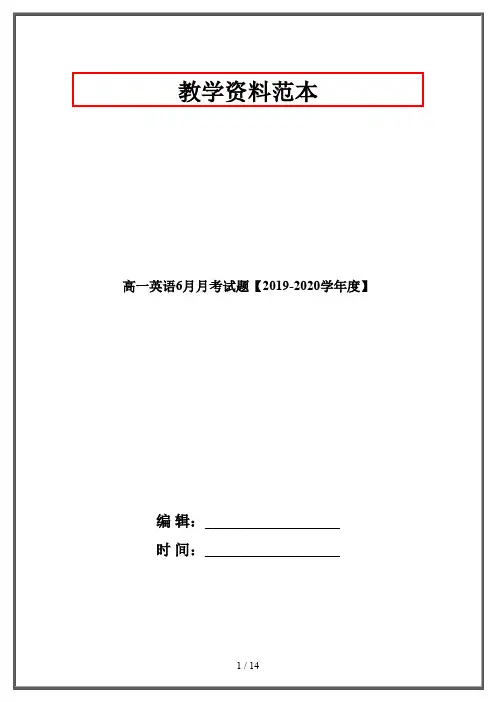
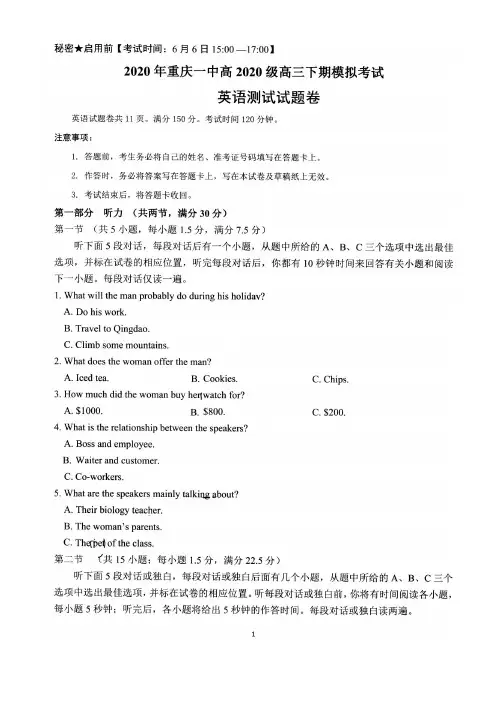
2020年重庆一中高2020级高三下期模拟考试英语测试试题答案第二节(共10小题;每小题1.5分,满分15分)61.to meet 62.lower 63.praying64.ideas 65.breathe 66.whose 67.it 68.of 69.hidden 70.have been drawn 第四部分写作(共两节,满分35分)第一节短文改错(共10小题;每小题1分,满分10分)I often wanted to look like as the slim girls on TV even though I knew it was impossible.To loseweight,I tried no-fat,low-fat,only bananas —I almost went madly.Then I read an article what said instead of asking “Am I fat?”I should be asking “Am I fit?”Ididn’t know a letter could make such ∧difference!Once I started thinking about fit rather than weight,things began to change.Rather than cutting out the foods I enjoyed,I adds healthy foods to my meals.Icould still have a burger now and then,but I would add a salad or an apple.Finally,I stopped compare myself with actresses and models.Instead,I made a list of the thing Iliked about myself.By being positive about me and my body,I became both happier or healthier.第二节书面表达(满分25分)Dear Sir/Madam,I’m Li Hua,an exchange student from China.Having read local community’s advertisement for volunteers on the promotion of Chinese traditional medicine,I can’t wait to submit my application for the post.Born in a family with both parents working in an institute of traditional Chinese medicine,I possess a thorough understanding of TCM,which I believe could be quite helpful.Additionally,as a madthat/whicha fitnessaddedcomparingmyselfandthingscompassionate and outgoing individual,I enjoying helping out wherever I can.Traditional Chinese medicine is ancient medical practice that has been used in China for more than 3,500years.Despite being a form of alternative medicine,it has worked wonders in many medical cases, such as the treatment of COVID-19.It really means a lot to me to promote TCM,so I do hope this wonderful chance would be offered to me.Looking forward to your reply.Yours Sincerely,Li Hua。
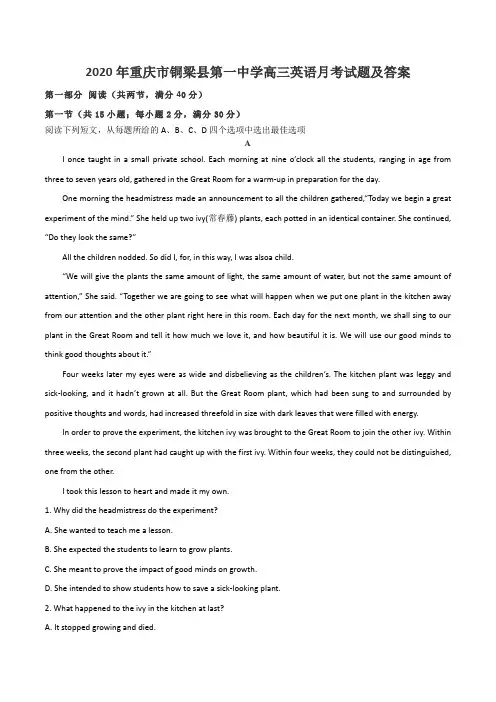
2020年重庆市铜梁县第一中学高三英语月考试题及答案第一部分阅读(共两节,满分40分)第一节(共15小题;每小题2分,满分30分)阅读下列短文,从每题所给的A、B、C、D四个选项中选出最佳选项AI once taught in a small private school. Each morning at nine o’clock all the students, ranging in age from three to seven years old, gathered in the Great Room for a warm-up in preparation for the day.One morning the headmistress made an announcement to all the children gathered,“Today we begin a great experiment of the mind.” She held up two ivy(常春藤) plants, each potted in an identical container. She continued, “Do they look the same?”All the children nodded. So did I, for, in this way, I was alsoa child.“We will give the plants the same amount of light, the same amount of water, but not the same amount of attention,” She said. “Together we are going to see what will happen when we put one plant in the kitchen away from our attention and the other plant right here in this room. Each day for the next month, we shall sing to our plant in the Great Room and tell it how much we love it, and how beautiful it is. We will use our good minds to think good thoughts about it.”Four weeks later my eyes were as wide and disbelieving as the children’s. The kitchen plant was leggy and sick-looking, and it hadn’t grown at all. But the Great Room plant, which had been sung to and surrounded by positive thoughts and words, had increased threefold in size with dark leaves that were filled with energy.In order to prove the experiment, the kitchen ivy was brought to the Great Room to join the other ivy. Within three weeks, the second plant had caught up with the first ivy. Within four weeks, they could not be distinguished, one from the other.I took this lesson to heart and made it my own.1. Why did the headmistress do the experiment?A. She wanted to teach me a lesson.B. She expected the students to learn to grow plants.C. She meant to prove the impact of good minds on growth.D. She intended to show students how to save a sick-looking plant.2. What happened to the ivy in the kitchen at last?A. It stopped growing and died.B. It was leggy and sick with dark leaves.C. It looked almost the same as the other one.D. It grew better than the one in the Great Room.3. What can be a suitable title for the passage?A. Life Means GrowthB. Things Grow with LoveC. Equality Makes a DifferenceD. Positive Thoughts Really CountBTofight for the conservation of forest ecosystem, several ecologists including Daniel Janzen convinced Del Oro, an orange juice producer, to donate part of their forestland to a national park. In return, Del Oro was allowed to throw large amounts of waste in the form of orangepeels(皮) on a 3-hectare piece of land within the national park at no cost. Dealing with tons of leftover peels usually involved burning them or paying to have them poured into a landfill, so the proposal was very attractive.But a year later, another juice company challenged the deal in court, arguing that their competitor was "polluting a national park". They ended up winning, and the deal between Del Oro and the national park fell through.Then in 2013, while discussing possible research avenues(途径,手段)with Timothy Treuer, Daniel Janzen mentioned the orange story. Feeling interested, Treuer decided to stop by that piece of land that had been covered with fruit waste 15 years earlier. What he found shocked him."While I would walk over exposed rock and dead grass in the nearby fields, I'd have to climb through undergrowth and cut paths through walls ofvines(藤) in the orange peel site itself," said Timothy Treuer.Treuer and his team spent months picking upsamples(样品), analyzing and comparing them. They found great differences between the areas covered with orange peels and those that were not. The area withorange waste had richer soil.The effect that the orange peels had on the land is probably not that surprising to people familiar withcomposting(施肥), but what is really shocking is that a judge actually thought the waste of orange "mined" a national parkand stopped it from going forward. Now that Timothy Treuer's study has received worldwide attention, this type of "ruining" is being seriously considered as a way of bringing forests back to life.4. What did Del Oro usually do with orange peels?A. Add them to fuel.B. Feed them to animals.C. Burn or bury them.D. Make them into cakes.5. What can we know about the deal between Del Oro and the national park?A. It lasted 15 years.B. It was signed by Treuer.C. It was made in about 1998.D. It was broken by Del Oro.6. What was Treuer's finding?A. Orange peels contain much fibre.B. Orange peels can make soil richer.C. Orange peels rot away in a short time.D. Orange waste ruined the national park.7. What is the author's attitude toward the judge mentioned in the last paragraph?A. Disapproving.B. Positive.C. Worried.D. Admirable.CYou run into the grocery store to quickly pick up your item. You grab what you need and head to the front of the store. After quickly sizing up the check-out lines, you choose the one that looks fastest. You chose wrong. People getting in other lines long after you have already checked out and headed to the parking lot. Why does this seem to always happen to you?Well, as it turns out, it's just math that is working against you. A grocery store tries to have enough employees at the checkout lines to get all their customers through with minimum delay. But sometimes, like on a Sunday afternoon, they get super busy. Because most grocery stores don't have the physical space to add more checkout lines, their system becomes overburdened. Some small interruption — a price check, a particularly talkative customer — will have downstream effects, holding up the entire line behind them.If there are three lines at the store, these delays will happen randomly at different registers (收银台). Think about the probability. The chances of your line being that fastest one are only one in three, which means you have a two-thirds chance of not being in the fastest line. So it's not just in your mind: Another line is probably moving faster thanyours.Now, mathematicians have come up with a good solution, which they call queuing theory, to this problem: Just make all customers stand in one long snaking line, called a serpentine line, and serve each person at the front with the next available register. With three registers, this method is about three times faster on average than the more traditional approach. This is what they do at most banks, Trader Joe's, and some fast-food places. With a serpentine line, a long delay at one register won't unfairly punish the people who lined up behind it. Instead, it will slow everyone down a little bit.8. What phenomenon is described in the first paragraph?A. Queuing in a line.B. A shopping experience.C. A rush in the morning.D. Cutting in a line.9. According to the article, what may cause delays in checking out?A. The lack of employees in the grocery store.B. Some unexpected delays of certain customers.C. The increasing items bought by customers.D. A worsening shopping system of the store.10. What is the solution given by mathematicians?A. Employing more workers for checking out.B. Limiting the number of queuing people.C. Making only one line available.D. Always standing in the same line.11. What's the principle behind the queuing theory?A. To pursue the maximum benefit.B. To leave success or failure to luck.C. To avoid the minimum loss.D. To spread the risk equally among everyone.DGuangzhououtbreak linked to strains inIndiaThe gene sequencing of the COVID-19 outbreak inGuangzhou.Guangdongprovince, indicates it is very similar in structure to the mutatedstrains detected inIndia, a senior health official from the city said on Sunday.“And it has the characteristic of quick spread.” Chen Bin, deputy director of the city's health commission, said at a news conference inGuangzhouon Sunday.She urged relevant departments and medical staff to act quickly to block the chain of infection and control the spread of the coronavirus in the southern metropolis.Zhang Zhoubin, deputy director of theGuangzhoucenter for disease control and prevention, said the strain of coronavirus spreads easily.“The virus can be spread through a meal or through a short period of indirect contact,” he said.The city reported five confirmed eases and 21 asymptomatic carriers as of 2 pm Sunday after the first confinned case was detected in the city's Liwan district on May 21, Chen said.To prevent the virus from spreading, the city government tightened its disease control and prevention measures over the weekend. Six communities and housing estates previously designated as low-risk areas were raised to medium-risk ones, Chen said.In addition to asking local residents to get vaccinated, the city has organized nucleic acid testing in Haizhu and Yuexiu districts starting from Sunday. Residents in specific areas of Tianhe, Baiyun and Panyu districts have also been required to take nucleic acid tests to expand the screening of suspected patients and asymptomatic carriers.Liwan previously required all its residents to take nucleic acid tests.As of Saturday, more than 2-25 million residents of the city have had samples collected for nucleic acid tests, Chen said. More than 10,000 medical workers from the entire city have been sent to Liwan to help vaccinate locals against COVID-19 and collect samples for nucleic acid testing.Deng Wenjun, director of circulation section with Guangzhou Supply and Marketing Cooperative, said there are sufficient supplies of food and daily necessities in the medium-risk areas.12. What is the characteristic of the COVID-19 which broke out inGuangzhou?A. It disappears quickly.B. It spreads fast.C. It has a lot to do with temperature.D. It has the same nature as the seasonal flu.13. Which district have residents who have not been required to take nucleic acid tests?A. Tianhe.B. Haizhu.C. Panyu.D. Zengcheng.14. Which of the following statements is TRUE?A. The virus can hardly be spread through a short period of indirect contact.B. There are 21 symptomatic carriers in the Liwan district as of 2 pm Sunday.C. All the people living in Liwan district arc previously asked to take nucleic acid tests.D. Supplies of food and daily necessities in the medium-risk areas arc still not enough.15. Where can you probably find this article?A. On a news website.B. In a fashion magazine.C. In a history book.D. In a travel journal.第二节(共5小题;每小题2分,满分10分)阅读下面短文,从短文后的选项中选出可以填入空白处的最佳选项。
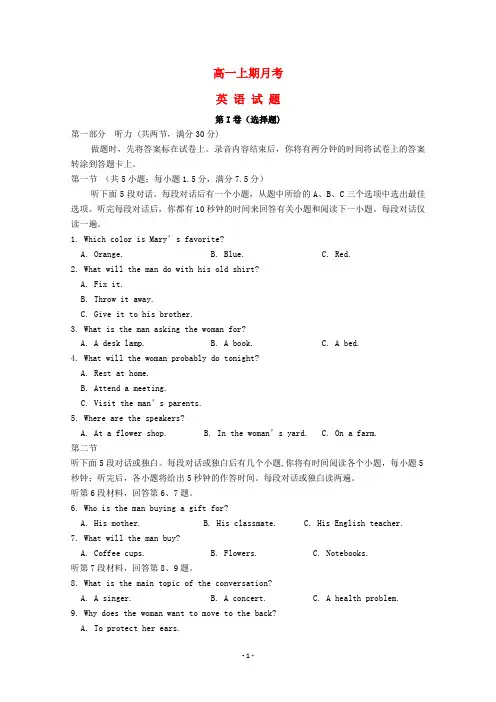
高一上期月考英语试题第I卷(选择题)第一部分听力 (共两节,满分30分)做题时,先将答案标在试卷上。
录音内容结束后,你将有两分钟的时间将试卷上的答案转涂到答题卡上。
第一节(共5小题;每小题1.5分,满分7.5分)听下面5段对话。
每段对话后有一个小题,从题中所给的A、B、C三个选项中选出最佳选项。
听完每段对话后,你都有10秒钟的时间来回答有关小题和阅读下一小题。
每段对话仅读一遍。
1. Which color is Mary’s favorite?A. Orange.B. Blue.C. Red.2. What will the man do with his old shirt?A. Fix it.B. Throw it away.C. Give it to his brother.3. What is the man asking the woman for?A. A desk lamp.B. A book.C. A bed.4. What will the woman probably do tonight?A. Rest at home.B. Attend a meeting.C. Visit the man’s parents.5. Where are the speakers?A. At a flower shop.B. In the woman’s yard.C. On a farm.第二节听下面5段对话或独白。
每段对话或独白后有几个小题,你将有时间阅读各个小题,每小题5秒钟;听完后,各小题将给出5秒钟的作答时间。
每段对话或独白读两遍。
听第6段材料,回答第6、7题。
6. Who is the man buying a gift for?A. His mother.B. His classmate.C. His English teacher.7. What will the man buy?A. Coffee cups.B. Flowers.C. Notebooks.听第7段材料,回答第8、9题。
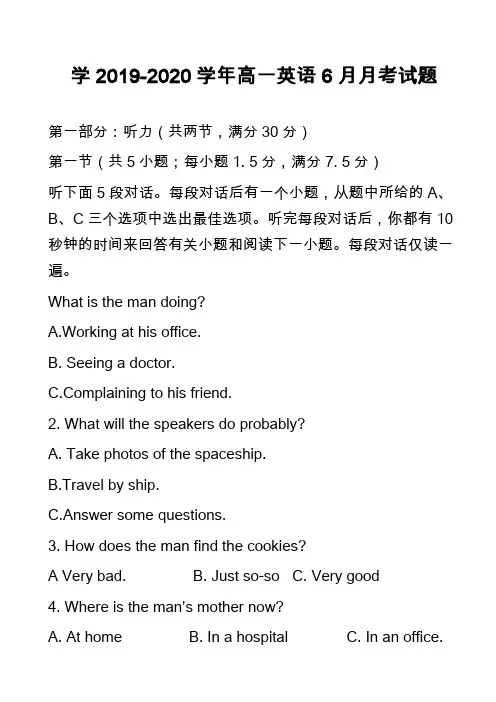
学2019-2020学年高一英语6月月考试题第一部分:听力(共两节,满分30分)第一节(共5小题;每小题1. 5分,满分7. 5分)听下面5段对话。
每段对话后有一个小题,从题中所给的A、B、C三个选项中选出最佳选项。
听完每段对话后,你都有10秒钟的时间来回答有关小题和阅读下一小题。
每段对话仅读一遍。
What is the man doing?A.Working at his office.B. Seeing a doctor.plaining to his friend.2. What will the speakers do probably?A. Take photos of the spaceship.B.Travel by ship.C.Answer some questions.3. How does the man find the cookies?A Very bad. B. Just so-so C. Very good4. Where is the man’s mother now?A. At homeB. In a hospitalC. In an office.5. What does the man mean?A. He hates to lend his toolsB. He hasn't finished workingC. He lost those tools.第二节(共15小题;每小题15分,满分22.5分)听下面5段对话或独白。
每段对话或独白后有几个小题,从题中所给的A、B、C三个选项中选出最佳选项。
听每段对话或独白前,你将有时间阅读各个小题,每小题5秒钟;听完后,各小题给出5秒钟的作答时间。
每段对话或独白读两遍。
听第6段材料,回答第6、7题。
6. Why is the man late for work this morning?A. He overslept.B.He couldn’t take the taxi.C. His clock didn't go off.7. How does the woman feel now?A. Grateful.B. Unhappy.C.Relieved.听第7段材料,回答第8、9题8. What does the man ask Maria to do?A. Care for his daughter.B. Look after his pet.C. Take care of his house.9. What relation is Lucy to the man?A. His daughter.B. His granddaughterC. His wife听第8段材料,回答第10至12题。
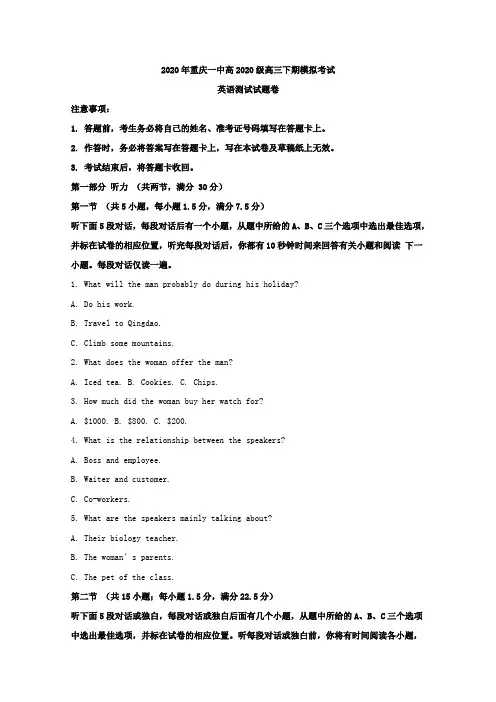
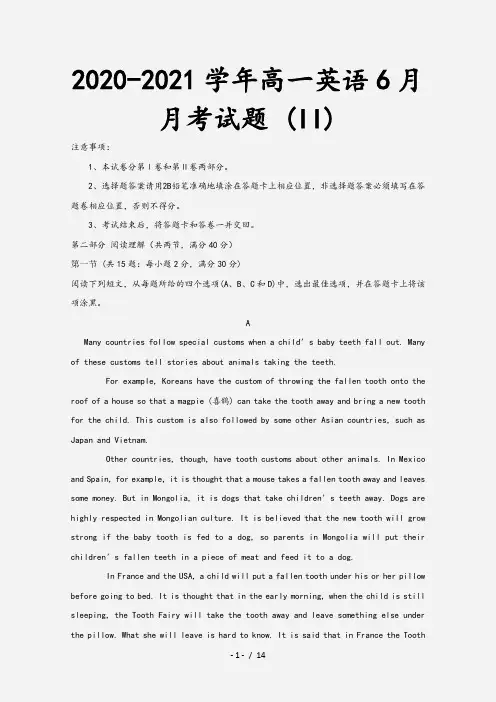
2020-2021学年高一英语6月月考试题 (II)注意事项:1、本试卷分第Ⅰ卷和第Ⅱ卷两部分。
2、选择题答案请用2B铅笔准确地填涂在答题卡上相应位置,非选择题答案必须填写在答题卷相应位置,否则不得分。
3、考试结束后,将答题卡和答卷一并交回。
第二部分阅读理解(共两节,满分40分)第一节(共15题:每小题2分,满分30分)阅读下列短文,从每题所给的四个选项(A、B、C和D)中,选出最佳选项,并在答题卡上将该项涂黑。
AMany countries follow special customs when a child’s baby teeth fall out. Many of these customs tell stories about animals taking the teeth.For example, Koreans have the custom of throwing the fallen tooth onto the roof of a house so that a magpie (喜鹊) can take the tooth away and bring a new tooth for the child. This custom is also followed by some other Asian countries, such as Japan and Vietnam.Other countries, though, have tooth customs about other animals. In Mexico and Spain, for example, it is thought that a mouse takes a fallen tooth away and leaves some money. But in Mongolia, it is dogs that take children’s teeth away. Dogs are highly respected in Mongolian culture. It is believed that the new tooth will grow strong if the baby tooth is fed to a dog, so parents in Mongolia will put their children’s fallen teeth in a piece of meat and feed it to a dog.In France and the USA, a child will put a fallen tooth under his or her pillow before going to bed. It is thought that in the early morning, when the child is still sleeping, the Tooth Fairy will take the tooth away and leave something else under the pillow. What she will leave is hard to know. It is said that in France the ToothFairy may leave some candies; however, in the United States, she may leave money.21.In Vietnam, i f a child’s tooth falls out, he or she will __________.A.throw it onto the roof of a houseB.feed it to a mouseC.put it in a piece of meat and feed the meat to a dogD.leave it to the Tooth Fairy22.From the last paragraph, we can know that in France and the USA _________.A.a child will put his or her fallen tooth beside the pillowB.the Tooth Fairy takes the fallen teeth away at midnightC.the Tooth Fairy will leave some candies to the children after taking the fallenteeth awayD.No one knows for sure what the Tooth Fairy will leave to the children aftertaking the fallen teeth away23.The passage is mainly about ___________.A.customs about fallen teeth in western countriesB.customs about fallen teeth in different countriesC.stories about human teethD.stories about some animalsBIt is well known that the Japanese people’s love of fish is almost as strong as a bee’s interest in honey. As fish populations were decreasing, fishing panies were forced to fish further and further away from the shore. Then they had a big challenge — how to keep the fish fresh for longer. So they decided to keep the fish stored in freezers on the boats. But the public did not like frozen fish. So again the fishing panies had a new bigger challenge. What they decided to do was to have fish tanks on their boats. After catching fishes,they would put them in the tanks and keep them living there until they got back to shore. But in this protected environment, lacking predators(掠食者), the fish slopped moving around. The Japanese public felt these dull fish did not taste fresh, which had an unpleasant effect uponsales. Once again the fishing panies had an even bigger challenge ...Stop for a minute! Before we go any further, I would like to ask “What are your challenges? Ho w do you handle an unexpected challenge?” May I think it this way that you should try to attack your challenges? Conquer them with a Swiss Army knife. Take the most proper and simple tool that you can adopt to deal with your situation.Now back to our story. How did the Japanese finally figure out the fresh fish problem? Sharks! You might think the same. Sharks were caught and put into the tanks with other fishes. Don’t sharks eat fish? Well, they do eat a few fish, but they did also keep more fish active and alert(警觉的). The fish stay fresh because they are challenged.Now, try to keep yourself fresh by finding your own shark to offer yourself a challenge in your own business and career.24. The main reason for the fishing pany to fish in the far sea is that___________.A. the fishes farther away from the sea tasted fresherB. the fish resource near the shore was decreasingC. people would prefer eating fresh fishes to less fresh onesD. it was getting harder and harder to keep fishes fresh25. Which was the best way for the fishing pany to keep fishes fresh?A. Getting the fishes frozen.B. Storing the fisheswith salt.C. Keeping the fishes with sharks in tanks.D. Putting the fishesin tanks26. The underlined part of the last paragraph means “___________.”A. If you went fishing, you might do as the fishing panies didB. To succeed in life, you should always be ready to meet challengesC. Try to find a big shark, and you will meet your challengeD. Sharks are usually pared to the challenges in pe ople’s life27. The purpose for the author to write the passage is to .A. tell the readers how the Japanese fishing panies workB. tell the readers how the Japanese keep the fish freshC. suggest readers finding a shark to keep the fish freshD. suggest readers looking for challenges to make progressCNowadays wind is useful. Think about the different ways that people use the wind. You can use it to fly a kite or to sail a boat. Wind is one of our cleanest and richest power sources, as well as one of the oldest. Evidence shows that windmills began to be used in ancient Iran back in the seventh century BC. They were first introduced to Europe during the 1100s, when armies returned from the Middle East with knowledge of using wind power.For many centuries, people used windmills to grind wheat into flour or pump water from deep underground. When electricity was discovered in the late 1800s, people living in remote areas began to use them to produce electricity. This allowed them to have electric lights and radio. However, by the 1940s, when electricity was available to people in almost all areas of the United States, windmills were rarely used.During the 1970s, people started being concerned about the pollution that is created when coal and gas are burned to produce electricity. People also realized that the supply of coal and gas would not last forever. Then, wind was rediscovered, though it means higher costs. Today, there is a global movement to supply more and more of our electricity through the use of wind.28. From the text we know that windmills _____.A. used to supply power to radio in remote areasB. have a history of more than 2800 yearsC. were invented by European armiesD. have rarely been used since electricity was discovered29. What was a new use for wind power in the late l9th century?A. Sailing a boat.B. Grinding wheat into flour.C. Producing electricityD. Pumping water from underground.30. One of the reasons wind was rediscovered in the 1970 is that _____.A. it is one of the oldest power sourcesB. wind power is cleanerC. it was cheaper to create energy from windD. the supply of coal and gas failed to meet needs31. What would the author probably discuss in the paragraph that follows?A. The global trend towards producing power from wind.B. The design of wind power plants.C. The worldwide movement to save energy.D. The advantage of wind power.DWhen I was 11, I glanced at Dad’s lunch box and made the unexpected discovery that my mother still showed her love towards my father. The evidence, a napkin (餐巾) resting on top of the sandwiches, was certain “Love you!” she had written on the napkin, “Meat loaf for supper!”Mom wrote all kinds of messages to Dad on those paper napkins, and he saved a whole pile of them. What embarrassed me as a kid has bee a precious memory of my parents.It also started my own brand of lunch box notes. When my kids were young, I’d glue little drawings on their lunches. Lots of sketches (素描) of our dog, Max, along with smiling flo wers. When they were teenagers, I’d copy words of wisdom from great people, Einstein, for example, or Bruce Springsteen. Then, my kids grew up making their own handwritten notes. And my husband writes me love notes on recycled paper, because he’s all about being green.Friends who know about my lunch box notes eagerly share stories of their own family traditions. So many focus on food. Maura’s mom always drew hearts on the shells of hard-boiled eggs. Melinda wrote messages on her kids’ bananas.We’re into t he third generation of lunch box notes in our home. Whenever my 3-year-old grandson, Clayton, spends the night, he knows his lunch is going to have a napkin note from Grandma in the morning. Last week, I drew a picture ofme, waving widely and shouting his name. He took one look at it and screamed, “Where’s Grandpa?” I added a man in a clean shirt. “You forgot his tie,” he said. I quickly drew a line of stripes (条纹) down the front of the shirt. Clayton smiled. “Grandpa,” he whispered, running his fingers across the napkin. “It’s you!”32. When the author first saw Dad’s lunch box notes, she felt ______.A. movedB. awkwardC. proudD. nervous33. What did the author put in the lunch boxes when her kids were in their teens?A. Words of love.B. Pictures of flowers.C. Drawings of their favorite animals.D. Famous words of wisdom.34. It can be inferred that ________.A. the author’s grandson likes drawing pictures on napkinsB. the author’s children dis like making lunch box notesC. the author’s husband is an environmentalistD. the author’s friends all had their brand of lunch box notes35. What’s the best title for the text?A. Old generation’s way of expressing love.B. A lunch box note.C. Lunches packed with love.D. Some interesting family traditions.第二节(共5小题;每小题2分,满分10分)根据短文内容,从短文后的选项中选出能填入空白处的最佳选项。
2019-2020年高一6月月考英语试题含答案第一部分:听力(共两节,满分30分)第一节(共5个小题;每小题1.5分,满分7.5分)听下面5段对话,每段对话后有一个小题,从题中所给的A、B、C三个选项中选出最佳选项,并标在试卷的相应位置。
听完每段对话后,你都有10秒钟的时间来回答有关小题和阅读下一小题,每段对话仅读一遍。
1. What will the woman do next?A. Help the manB. Finish her homeworkC. Watch a program2. What does the woman mean?A. It's too cold this winter.B. Cold beer is harmful to health.C. The man should drink less beer.3. How much does the man have to pay?A. $ 90B. $ 162C. $ 180.4. Why does the man have so many clocks?A. He has trouble getting up.B. He often forgets about time.C. He likes collecting clocks.5. What can we infer about the speakers?A. They've known each other.B. They're having coffee together.C. They think the coffee shop too small. 第二节 (共15个小题;每小题1.5分,满分22.5分) 听下面5段对话或独白。
每段对话或独白后有几个小题,从题中所给的A、B、C三个选项中选出最佳选项,并标在试卷的相应位置。
听每段对话或独白前,你将有时间阅读各个小题,每小题5秒钟;听完后,各小题将给出5秒钟的作答时间。
2020年重庆市铜梁县第一中学高三英语月考试题及答案解析第一部分阅读(共两节,满分40分)第一节(共15小题;每小题2分,满分30分)阅读下列短文,从每题所给的A、B、C、D四个选项中选出最佳选项AOn the 100th anniversary of the Communist Party of China (CPC), red tourism has gained popularity among tourists who flood in to visit historic sites with a modern revolutionary heritage.JinggangshanThis is one of the most crucial and splendid chapters of history of establishing Red China as well as a unique and wonderful ecosystem, which is covered with rich forest, rugged peaks and several memorials to the Red Army. The best time to visit is between April and October, with the most temperature timing April and May when the large azaleas (杜鹃花) bloom.Open: 8:00-17:00 (Feb. 16-Nov. 15). 8:00-16:30 (Nov. 16-Feb. 15)XibaipoIt is an old revolutionary base where the leadership of the Communist Party of China was stationed, drawing up the blueprint for a new country. A memorial hall was built to honor the memory of this site. The lake and the hill here add brilliance and beauty to each other and form pleasant scenery.Open: Tuesdays to Sundays 9:30-17:00 (Xibaipo Memorial Hall)The Nanhu Revolutionary Memorial HallA new exhibition is held with updated display approaches, including phantom imaging (全息影像) and oil painting, which are used to improve visitors' experiences. The exhibition shows four stages of the CPC from its establishment to its achievements.Open: Tuesdays to Sundays 8:30-18:00 (closed on Mondays)Former Site of the Editorial Department ofNew YouthNew Youthstarted the New Culture Movement and spread the influence of the May Fourth Movement. The site was briefly based in Beijing but moved back to Shanghai in 1920 and also served as the office for the Communist Party of China Central Committee in the 1920s.Open: Thursdays to Tuesdays 9:00 - 11:30, 13:30 - 16:30 (closed on Wednesdays)1. Where would visitors learn more about the history of the Red Army?A. Jinggangshan.B. Xibaipo.C. The Nanhu Revolutionary Memorial Hall.D. Former Site of the Editorial Department ofNew Youth.2. What do we know about the Nanhu Revolutionary Memorial Hall?A. It focuses on Chinese achievements in art.B. It mainly advertises the coming anniversary.C. It applies modernized methods to the exhibition.D. It briefly introduces the rise and fall of Nanhu.3. When can tourists visit Former Site of the Editorial Department ofNew Youth?A. At 1:00 p.m. on Mondays.B. At 9:00 a.m. on Wednesdays.C. At 2:00 p.m. on Fridays.D. At 5:00 p.m on Sundays.BYour house may have an effect on your figure.Experts say the way you design your home could play a role in whether you pack on the pounds or keep them off. You can make your environment work for you instead of against you. Here are some ways to turn your home into part of your diet plan.Open the curtains and turn up the lights. Dark environments are more likely to encourage overeating, for people are often less selfconscious (难为情) when they’re in poorly lit places—and so more likely to eat lots of food. If your home doesn’t have enough window light, get more lamps and flood the place with brightness.Mind the color1 s. Research suggests warm color1 s fuel our appetites. In one study, people who ate meals in a blue room consumed 33 percent less than those in a yellow or red room. Warm color1 s like yellow make food appear more appetizing, while cold color1 s make us feel less hungry. So when it’s time to repaint, go blue.Don’t forget the clock—or the radio. People who eat slowly tend to consume about 70 fewer calories (卡路里) per meal than those who rush through their meals. Begin keeping track of the time, and try to make dinner last at least 30 minutes. And while you’re at it, actually sit down to eat. If you need some help slowing down, turn on relaxing music. It makesyou less likely to rush through a meal.Downsize the dishes. Big serving bowls and plates can easily make us fat. We eat about 22 percent more when using a 12inch plate instead of a 10inch plate. When we choose a large spoon over a smaller one, total intake (摄入) jumps by 14 percent. And we’ll pour about 30 percent more liquid into a short, wide glass than a tall, skinny glass.4. The text is especially helpful for those who care about ____________.A. their home comfortsB. their body shapeC. house buyingD.healthy diets5. A home environment in blue can help people ______________.A. digest food betterB. reduce food intakeC. burn more caloriesD. regain their appetites6. What are people advised to do at mealtimes?A. Eat quickly.B. Play fast music.C. Use smaller spoons.D. Turn down the lights.7. What can be a suitable title for the text?A. Is Your House Making You Fat?B. Waysof Serving DinnerC. Effects of SelfConsciousnessD. Is Your Home Environment Relaxing?CA 10-year-old swimmer with sky-high dreams and a name to match them has broken a record previously held by Olympian Michael Phelps.Clark Kent Apuada, whose friends call him“Superman", swam the 100-meter butterfly in 1:09.38 at the Far Western Long Course Championships in his home state of California this Sunday. That's a second faster than the record Phelps set at the same event in 1995 with a time of 1: 10. 48 in the same category of boys under 10.Clark, a rising fifth-grader who is Filipino-American, told HuffPost he's been dreaming about breaking Phelps' record ever since he started swimming competitively at age 7."I was so motivated,"Clarksaid about his win."I was so happy that I was able to beat that record.”Phelps competed in his first Olympics at age 15. He went on to become the mostdecoratedOlympian in history, with 28 medals overall. “Everyone in the crowd was excited when they realized what a special swim they had just seen when we announced the long-standing record had been broken,"Cindy Rowland,Pacific Swimming's director, wrote in an email.Clarkwon first place for all the swimming events he competed in at this year's Far Western Championships. Pacific Swimming or PacSwim, a regional association that is part of USA Swimming, organizes the Far Western Long Course Championships. Cynthia Apuada,Clark' s mother,said that her child seems to be “living by his name at this point”。
2019-2020学年高一英语6月月考试题(16)本试卷分为第I卷(选择题)和第II卷(非选择题)。
请把试卷I的答案转涂到答题卡上,试卷II的答案写在答题卡上。
不能答在本试卷上,否则无效。
试卷满分为150分,考试时间120分钟。
第一部分听力(共两节,共20小题,满分30分)第一节(共5小题;每小题1.5分,满分7.5分)听下面5段对话。
每段对话后有一个小题,从题中所给的A、B、C三个选项中选出最佳选项。
听完每段对话后,你都有10秒钟的时间来回答有关小题和阅读下一小题。
每段对话仅读一遍。
1. What does the man plan to do?A. Go fishing.B. Go jogging.C. Go camping.2. What does the woman make little time for?A. Activities.B. Her family.C. Office work.3. What kind of bus pass does the woman probably want?A. Weekly.B. Monthly.C. Yearly.4. What does the woman want help with?A. Booking a flight.B. Asking for time off work.C. Paying for a plane ticket.5. How does the man feel about the spilled drink?A. Lucky.B. Worried.C. Surprised.第二节(共15小题: 每小题1.5分,满分22.5分)听下面5段对话或独白。
每段对话或独白后有几个小题,从题中所给的A、B、C三个选项中选出最佳选项。
听每段对话或独白前,你将有时间阅读各个小题,每小题5秒钟;听完后,各小题将给出5秒钟的作答时间。
一中高一年级月考英语试题答案与解析听力1-5CBBAC 6-10ACABC 11-15BCABA 16-20CBBCA阅读 21 DCC 24 DCBA 28 BDCA 32 BAAD 36 G C E B D完形填空41. D C B A C 46. B C A D B51. A D C B A 56. D C A B D语法填空61. which 62. beneficial 63. measures 64. that 65. calling 66. to 67. were delivered 68. what 69. kindness 70. extremely词汇应用71. referred 72. surrounded 73. from 74. account 75. existence书面表达Dear Tom,How are things going recently? With the Dragon Boat Festival approaching, I am writing to invite you to celebrate it with us this Saturday.Also called the Duanwu Festival, the Dragon Boat Festival is celebrated on the fifth day of the fifth month according to the Chinese lunar calendar. The festivalis best known for its dragon-boat races. On this day, we will watch dragon boat races. In addition, we always eat rice dumplings made of glutinous rice, meat and so on, in memory of Qu Yuan, a man devoted to his country.I sincerely hope you can come and enjoy this festival with me. Looking forward to your earliest reply.Yours,Li HuaA篇【分析】本文章主要讲述了几那么志愿者招聘广告,对每种工作内容、联络人以及等进展了说明.21. D.细节理解题.根据文章Field trip guide介绍局部, Looking for volunteers 〔18 or older〕 to help at a station for our Discover Wildlife Journeys field trip for 4th ﹣ 6th graders! 寻找志愿者〔18岁或者以上〕在一个车站帮助我们 Discover Wildlife Journeys ,同时为4﹣6年级学生实地旅行提供帮助!可知,实地旅行的志愿者要求必须年满18周岁,结合选项,应选D.22. C.细节理解题.根据文章 Sales clerk介绍内容,Contact: Volunteer Clearinghouse 800﹣865﹣8337﹣Volunteers will help customers and provide cashier 〔出纳员〕 duties in a small bookstore.志愿者将在一家小书店帮助顾客并提供出纳效劳,联络为 800﹣865﹣8337.可知,想在书店上班请拨打 800﹣865﹣8337,结合选项,应选C.23. C.推理判断题.根据文章RV volunteer﹣Suitability: Adults, Groups, Family.合适性:成人、团体、家庭.可知, RV volunteer更合适家庭志愿者,结合选项,应选C.B篇本文章主要讲述了HY作家Alice Walker 的生平以及HY著名诗人 Langston Hughes对她的影响和帮助.24. D.细节理解题.根据文章第一段,Alice Walker makes her living by writing. And her poems, short stories, and novels have won many prizes for her. Alice Walker 靠写作谋生,她的诗歌、短篇小说和小说为她赢得了许多奖项.可知,Alice Walker 是一位获得很多奖项的作家,结合选项,应选D.25. C.推理判断题.根据文章第二段, she says," After my first meeting with Langston Hughes, I promised I would write a book for children someday. Why? Because I, at twenty﹣two, knew next to nothing of his work, and he didn't scold me."她说:"在我第一次见到Langston Hughes之后,我容许有一天我会为孩子们写一本书.为什么?因为那时我22岁,对他的作品几乎一无所知,但是他也没有骂我."可知,Alice Walker 22岁时第一次遇到了Langston Hughes,结合选项,应选C.26. B.词义猜想题。
重庆市铜梁一中2018-2019学年高一英语3月月考试题(无答案)第I卷注意事项:1. 答第I卷前,考生务必将自己的姓名、准考证号、考场号填写在答题卡上。
2. 选出每小题答案后,用铅笔把答题卡上对应题目的答案标号涂黑。
如需改动,用橡皮擦干净后,再选涂其他答案标号。
不能答在本试卷上,否则无效。
第一部分听力(共两节,满分30分)第一节听下面5段对话。
每段对话后有一个小题,从题中所给的A、B、C三个选项中选出最佳选项。
听完每段对话后,你都有10秒钟的时间来回答有关小题和阅读下一小题。
每段对话仅读一遍。
1. What is the dog doing now?A. Playing.B. Sleeping.C. Eating.2. What does the man ask for?A. Coffee.B. Sugar.C. Salt.3. Why won’t the woman watch the game with the man tonight?A. She has to work late.B. She wants to visit Sally.C. She doesn’t like basketball.4. How much will the woman lend the man?A. £5.B. £7.C. £9.5. Where will the speakers study tonight?A. In the school library.B. At the man’s house.C. At the house of the man’s sister.第二节听下面5段对话或独白。
每段对话或独白后有几个小题,从题中所给的A、B、C三个选项中选出最佳选项。
听每段对话或独白前,你将有时间阅读各个小题,每小题5秒钟;听完后,各小题将给出5秒钟的作答时间。
每段对话或独白读两遍。
重庆市铜梁县第一中学2020学年高一英语6月月考试题本试卷分第Ⅰ卷和第Ⅱ卷两部分,共12页。
第Ⅰ卷为选择题, 共100分;第Ⅱ卷为非选择题,共50分。
全卷共150分,考试时间为120分钟。
第I卷第一部分听力(共两节,满分30分)第一节听下面5段对话。
每段对话后有一个小题,从题中所给的A、B、C三个选项中选出最佳选项并标在试卷的相应位置。
听完每段对话后,你都有10秒钟的时间来回答有关小题和阅读下一小题。
每段对话仅读一遍。
1.Who wants to borrow the camera?A.JaneB. AliceC. David2.What does the man mean?A.Buy some more paint.B.Get someone to help them.C.Finish painting the rooms tomorrow.3.Where does the conversation take place?A.In a shopB. In a supermarketC. In a restaurant4.What does the woman want to do?A.Buy tickets.B. Exchange notesC. Have the machine repaired5.What’s the regular price for the woman’s haircut?A.20 yuan.B. 40 yuanC. 60 yuan.第二节听下面5段对话或独白。
每段对话或独白后有几个小题,从题中所给的A、B、C三个选项中选出最佳选项并标在试卷的相应位置。
每段对话读两遍。
听下面一段对话,回答第6和第7两个小题6.How many people are there in Steven’s family?A.FourB. FiveC. Six7.Who is an office clerk?A.Steven’s motherB.Steven’s fatherC.Steven’s brother听下面一段对话,回答第8和第9两个小题8.Why does the man talk to the woman?A.To cancel an appointment.B.To change an appointment.C.To make an appointment.9.What does Mr. Green do?A. A manager.B. A dentist.C. A teacher.听下面一段对话,回答第10至12三个小题10.What did the man do last night?A.He fixed his phone.B.He went to a party.C.He went out for dinner.11.Why did the woman call the man?A.To play games with him.B.To tell him the homework.C.To get help from him.12.Whom will the woman call next?A.Jane.B.Henry.C.Lewis.听下面一段对话,回答第13至16四个小题13.What are the speakers talking about?A. A weekend plan.B. A concert.C. A dance party.14.What day is it today?A.SaturdayB.FridayC.Thursday15.Why won’t the man go to the Cool Bar?A.He dislikes the music.B.It is always too crowded.C.The food is too expensive.16.What is the woman’s problem?A.She can’t understand Latin.B.She doe sn’t like Latin music.C.She is not good at Latin dance.听下面一段独白,回答第17至20四个小题17.Why is the speaker going to Australia?A.His sister just gave birth to a baby.B.His sister will get married.C.His sister is terribly ill.18.What will the speaker do in Sydney?A.See a show.B.Visit his friends.C.Do some scuba-diving.19.Where will the speaker go on the 10th?A.Sydney.B.Melbourne.C.Canberra.20.When will the speaker arrive in London?A.On the 10th.B.On the 11th.C.On the 12th.第二部分阅读理解(共两节,满分40分)第一节(共15小题:每小题2分,满分30分)阅读下列短文,从每题所给的网个选项(A、B、C和D)中,选出最佳选项,并在答题卡上将该项涂黑。
ASix million people visit Grand Canyon in the US every year. For the purpose of helping project Grand Canyon for your fellow visitors and future generations, please follow the guidelines below.CampingTo protect the park, camping is allowed only within permitted campgrounds. Permits are required for overnight camping at the North Rim. Advance booking can be received by mail. Please write: Information Center, P.O. Box 129, Grand Canyon, AZ 86023.FiresBecause of the extreme fire danger, campfires are not allowed except at Mather and Desert View campgrounds. Collection of firewood is not allowed either. Hiking(远足)Please stay on permitted paths. Otherwise you may destroy desert plants. Pack out what you pack in, so you leave no signs of your visit. It is importantto keep in mind that you are in a national park where wildlife exists. WeatherThe weather at Grand Canyon can change very quickly. With so much rock, lightning(闪电) causes a particular danger during sudden summer storms These storms also frequently bring floods inside valleys, a danger to hikers. Watch the skies and check daily weather reports.WildlifeDo not feed park wildlife. There have been a few cases at Grand Canyon National Park where deer(鹿) were purposely shot because there are plastic bags that left them sick and weak. Hungry deer can be danger and have kicked and bitten visitors at Grand Canyon. Some other animals will also beg and bite. For your own safety and the well-being of the animals, please do not feed wildlife, no matter how gentle they may appear.21. What can you do first if you want to go camping?A. Know the permitted pathsB. Stop at Mather and Desert ViewC. Make sure not to make a fireD. Book campgrounds in advance22.What do the underlined words “pack out what you pack in” in Paragraph4 probably mean?A. keep everything out of campgroundsB. take away everything you bring inC. carry all the necessary foodD. look after your personal belongings23. Why were some deer killed on purpose at Grand Canyon?A. They begged food from visitorsB. They were a danger to other gentle animalsC. They ate wrong things and become very illD. They kicked and bit visitors24. What is the main purpose of the text?A. To provide travel informationB. To report some recent newsC. To teach tourists hiking skillsD. To introduce the wild lifeBNot only kids of Tiger Moms go to Harvard.Dawn Loggins of Lawndale, N.C. is on her way to Harvard, one of the eight world-famous universities in the eastern US. Nobody encouraged her to study or paid for her special classes. This girl created her own future.The teen was abandoned by her family last summer, when her parents and two sisters moved to Tennessee. She found herself homeless and had to spend the night on friend's sofas.The school bus driver learned about Dawn's situation and invited Dawn to move in with her family. Soon, Dawn had a job at Burns High School. She worked from 6 a.m. to 7:40 a.m. before the first school bell rang. She swept floors and picked up trash again in the afternoons, before diving into her studies in the evenings.Dawn's hard work paid off. She finished school with a 3.9 GPA and scored 2,110 on the SAT."There were times when I felt like it would be easiest if I gave up," the 18-year-old said."But it was never in me to give up, because I realized that I was never going to be successful unless I got an education."Even before Dawn's family left her, she led a difficult life. Her family was poor and cups of noodles were often the only food. Dawn "studied by candlelight" because her parents couldn't afford to pay the electricity bill(电费).Dawn has now reconnected with her family. They are proud of her accomplishments(成就) and are attending her high school graduation.25. What does the underlined word "abandoned" mean in Chinese?A. looked afterB. given upC. worried aboutD. thought of26. Who helped Dawn when she found herself homeless?A. Her teachers.B. Her neighbors.C. A Tiger Mom.D. A school bus driver.27. Which of the following words describes Dawn?A. Open-minded.B. Good-natured.C. Strong-willed.D. Warm-hearted28. What is the best title for the text?A. Another Harvard girl.B. A girl in candle light.C.The role of Tiger Moms.D. From homeless to Harvard.CDoes this situation seem familiar to you? Your English is progressing well, the grammar is now familiar, the reading comprehension is no problem, you are communicating quite fluently, but: Listening is STILL a problem! First of all, remember that you are not alone. Listening comprehension is probably the most difficult job for almost all learners of English as a foreign language. The most important thing is to listen as often as possible. The first step is to find listening resources. The Internet is really a useful tool for English students. You can download The RealPlayer from RealMedia. The RealPlayer allows you to use the Internet like a radio station.Once you have begun to listen on a regular basis, you might still be frustrated (懊恼) by limited understanding. What should you do?Here is some of the advice I give my students:●Accept the fact that you are not going to understand everything.●Stay relaxed when you do not understand—even if you continue not to understand for a long time.●Do not translat e what you hear into your native language.●Listen for the general idea of the conversation. Don’t concentrate on detail until you have understood the main ideas.I remember the problems I had in understanding spoken German when I first went to Germany. In the beginning, when I didn't understand a word, I insisted on translating it in my mind. This method usually resulted in confusion. Then, after the first six months, I discovered two very important facts. Firstly, translating creates a wall between the listener and the speaker. Secondly, most people repeat themselves constantly. By remaining calm, I noticed that —even if I didn’t pay much attention, I could usually understand what the speaker had said.29.The best way to improve our listening is to _________ .A. practise as much as possibleB. use the Internet like a radio stationC. find as many listening resources as possibleD. speak naturally and read as much as possible30.Which of the following is a good habit when listening?A. Try to understand everything.B. Try to get the main ideas.C. Pay much attention to details.D. Translate each word in your mind.31.Why did the writer mention his/her experience in Germany?A. To prove the importance of translating.B. To tell us the importance of staying calm.C. To point out an ineffective method of listening.D. To show the problems of speaking a foreign language.DAsk someone what they have done to help the environment recently and they will almost certainly mention recycling. Recycling in the home is very important of course. However, being forced to recycle often means we already have more material than we need. We are dealing with the results of that over-consumption in the greenest way possible, but it would be far better if we did not need to bring so much material home in the first place. The total amount of packaging(包装) increased by 12% between 2020 and 2020. It now makes up a third of a typical household's waste in the UK. In many supermarkets nowadays food items are packaged twice with plastic and cardboard.Too much packaging is doing serious damage to the environment. The UK, for example, is running out of it for carrying this unnecessary waste. If such packaging is burnt, it gives off greenhouse gases which go on to cause the greenhouse effect. Recycling helps, but the process itself uses energy. The solution is not to produce such items in the first place. Food waste is a serious problem, too. Too many supermarkets encourage customers to buy more than they need. However, a few of them are coming round to the idea that this cannot continue, encouraging customers to reuse their plastic bags, for example.But this is not just about supermarkets. It is about all of us. We have learned to associate packaging with quality. We have learned to think that something unpackaged is of poor quality. This is especially true of food. But it also applies to a wide range of consumer products, which often have far more packaging than necessary.There are signs of hope. As more of us recycle, we are beginning to realise just how much unnecessary material we are collecting. We need to face the wastefulness of our consumer culture, but we have a mountain to climb. 32. What does the underlined phrase "over-consumption" refer to?A. Using too much packagingB. Recycling too many wastesC. Making more products than necessaryD. Having more material than is needed33. The author uses figures in Paragraph 2 to show .A. the tendency of cutting household wasteB. the fact of packaging overuseC. the rapid growth of super marketsD. the increase of packaging recycling34. According to the text, recycling .A. helps control the greenhouse effectB. means burning packaging for energyC. is the solution to gas shortageD. leads to a waste of land35. What can be inferred from Paragraph 4?A. Unpackaged products are of bad qualityB. Supermarkets care more about packagingC. Other products are better packaged than foodD. It is improper to judge quality by packaging第二节(共5小题;每小题2分满分10分)根据短文内容,从短文后的选项中选出能填入空白处的最佳选项。